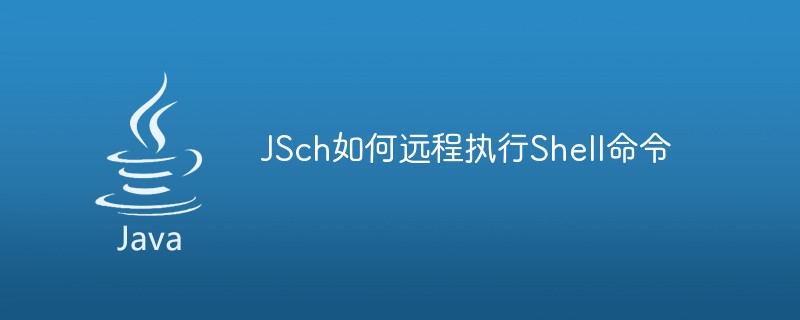JSch如何远程执行Shell命令
本篇文章给大家详细介绍一下用JSch远程执行Shell命令的方法。有一定的参考价值,有需要的朋友可以参考一下,希望对大家有所帮助。

JSch 是Java Secure Channel的缩写。JSch是一个SSH2的纯Java实现。它允许你连接到一个SSH服务器,并且可以使用端口转发,X11转发,文件传输等,当然你也可以集成它的功能到你自己的应用程序。框架jsch很老的框架,更新到2016年,现在也不更新了。
JSch 使用 shell 执行命令,有两种方法
ChannelExec: 一次执行一条命令,一般我们用这个就够了。
ChannelShell: 可执行多条命令,平时开发用的不多,根据需要来吧;
ChannelExec channelExec = (ChannelExec) session.openChannel("exec");//只能执行一条指令(也可执行符合指令)
ChannelShell channelShell = (ChannelShell) session.openChannel("shell");//可执行多条指令 不过需要输入输出流1. ChannelExec
每个命令之间用 ; 隔开。说明:各命令的执行给果,不会影响其它命令的执行。换句话说,各个命令都会执行,但不保证每个命令都执行成功。
每个命令之间用 && 隔开。说明:若前面的命令执行成功,才会去执行后面的命令。这样可以保证所有的命令执行完毕后,执行过程都是成功的。
每个命令之间用 || 隔开。说明:|| 是或的意思,只有前面的命令执行失败后才去执行下一条命令,直到执行成功一条命令为止。
2. ChannelShell
对于ChannelShell,以输入流的形式,可执行多条指令,这就像在本地计算机上使用交互式shell(它通常用于:交互式使用)。如要要想停止,有两种方式:
发送一个exit命令,告诉程序本次交互结束;
使用字节流中的available方法,来获取数据的总大小,然后循环去读。
使用示例
1. 引入 pom 依赖
<dependency> <groupId>com.jcraft</groupId> <artifactId>jsch</artifactId> <version>0.1.53</version> </dependency>
2. jsch 使用示例
在此封装了一个 Shell 工具类,用来执行 shell 命令,具体使用细节在代码注释中有说明,可以直接拷贝并使用,代码如下:
package org.example.shell;/**
* Created by qianghaohao on 2021/3/28
*/import com.jcraft.jsch.ChannelExec;import com.jcraft.jsch.JSch;import com.jcraft.jsch.Session;import java.io.BufferedReader;import java.io.IOException;import java.io.InputStreamReader;/**
* @description:
* @author: qianghaohao
* @time: 2021/3/28
*/public class Shell {
private String host;
private String username;
private String password;
private int port = 22;
private int timeout = 60 * 60 * 1000;
public Shell(String host, String username, String password, int port, int timeout) {
this.host = host;
this.username = username;
this.password = password;
this.port = port;
this.timeout = timeout;
}
public Shell(String host, String username, String password) {
this.host = host;
this.username = username;
this.password = password;
}
public String execCommand(String cmd) {
JSch jSch = new JSch();
Session session = null;
ChannelExec channelExec = null;
BufferedReader inputStreamReader = null;
BufferedReader errInputStreamReader = null;
StringBuilder runLog = new StringBuilder("");
StringBuilder errLog = new StringBuilder("");
try {
// 1. 获取 ssh session
session = jSch.getSession(username, host, port);
session.setPassword(password);
session.setTimeout(timeout);
session.setConfig("StrictHostKeyChecking", "no");
session.connect(); // 获取到 ssh session
// 2. 通过 exec 方式执行 shell 命令
channelExec = (ChannelExec) session.openChannel("exec");
channelExec.setCommand(cmd);
channelExec.connect(); // 执行命令
// 3. 获取标准输入流
inputStreamReader = new BufferedReader(new InputStreamReader(channelExec.getInputStream()));
// 4. 获取标准错误输入流
errInputStreamReader = new BufferedReader(new InputStreamReader(channelExec.getErrStream()));
// 5. 记录命令执行 log
String line = null;
while ((line = inputStreamReader.readLine()) != null) {
runLog.append(line).append("\n");
}
// 6. 记录命令执行错误 log
String errLine = null;
while ((errLine = errInputStreamReader.readLine()) != null) {
errLog.append(errLine).append("\n");
}
// 7. 输出 shell 命令执行日志
System.out.println("exitStatus=" + channelExec.getExitStatus() + ", openChannel.isClosed="
+ channelExec.isClosed());
System.out.println("命令执行完成,执行日志如下:");
System.out.println(runLog.toString());
System.out.println("命令执行完成,执行错误日志如下:");
System.out.println(errLog.toString());
} catch (Exception e) {
e.printStackTrace();
} finally {
try {
if (inputStreamReader != null) {
inputStreamReader.close();
}
if (errInputStreamReader != null) {
errInputStreamReader.close();
}
if (channelExec != null) {
channelExec.disconnect();
}
if (session != null) {
session.disconnect();
}
} catch (IOException e) {
e.printStackTrace();
}
}
return runLog.toString();
}}上述工具类使用:
package org.example;import org.example.shell.Shell;/**
* Hello world!
*
*/public class App {
public static void main( String[] args ) {
String cmd = "ls -1";
Shell shell = new Shell("192.168.10.10", "ubuntu", "11111");
String execLog = shell.execCommand(cmd);
System.out.println(execLog);
}}推荐:《java视频教程》
以上是JSch如何远程执行Shell命令的详细内容。更多信息请关注PHP中文网其他相关文章!

热AI工具

Undresser.AI Undress
人工智能驱动的应用程序,用于创建逼真的裸体照片

AI Clothes Remover
用于从照片中去除衣服的在线人工智能工具。

Undress AI Tool
免费脱衣服图片

Clothoff.io
AI脱衣机

Video Face Swap
使用我们完全免费的人工智能换脸工具轻松在任何视频中换脸!

热门文章

热工具

记事本++7.3.1
好用且免费的代码编辑器

SublimeText3汉化版
中文版,非常好用

禅工作室 13.0.1
功能强大的PHP集成开发环境

Dreamweaver CS6
视觉化网页开发工具

SublimeText3 Mac版
神级代码编辑软件(SublimeText3)
 突破或从Java 8流返回?
Feb 07, 2025 pm 12:09 PM
突破或从Java 8流返回?
Feb 07, 2025 pm 12:09 PM
Java 8引入了Stream API,提供了一种强大且表达力丰富的处理数据集合的方式。然而,使用Stream时,一个常见问题是:如何从forEach操作中中断或返回? 传统循环允许提前中断或返回,但Stream的forEach方法并不直接支持这种方式。本文将解释原因,并探讨在Stream处理系统中实现提前终止的替代方法。 延伸阅读: Java Stream API改进 理解Stream forEach forEach方法是一个终端操作,它对Stream中的每个元素执行一个操作。它的设计意图是处
 Java程序查找胶囊的体积
Feb 07, 2025 am 11:37 AM
Java程序查找胶囊的体积
Feb 07, 2025 am 11:37 AM
胶囊是一种三维几何图形,由一个圆柱体和两端各一个半球体组成。胶囊的体积可以通过将圆柱体的体积和两端半球体的体积相加来计算。本教程将讨论如何使用不同的方法在Java中计算给定胶囊的体积。 胶囊体积公式 胶囊体积的公式如下: 胶囊体积 = 圆柱体体积 两个半球体体积 其中, r: 半球体的半径。 h: 圆柱体的高度(不包括半球体)。 例子 1 输入 半径 = 5 单位 高度 = 10 单位 输出 体积 = 1570.8 立方单位 解释 使用公式计算体积: 体积 = π × r2 × h (4
 PHP与Python:了解差异
Apr 11, 2025 am 12:15 AM
PHP与Python:了解差异
Apr 11, 2025 am 12:15 AM
PHP和Python各有优势,选择应基于项目需求。1.PHP适合web开发,语法简单,执行效率高。2.Python适用于数据科学和机器学习,语法简洁,库丰富。
 PHP:网络开发的关键语言
Apr 13, 2025 am 12:08 AM
PHP:网络开发的关键语言
Apr 13, 2025 am 12:08 AM
PHP是一种广泛应用于服务器端的脚本语言,特别适合web开发。1.PHP可以嵌入HTML,处理HTTP请求和响应,支持多种数据库。2.PHP用于生成动态网页内容,处理表单数据,访问数据库等,具有强大的社区支持和开源资源。3.PHP是解释型语言,执行过程包括词法分析、语法分析、编译和执行。4.PHP可以与MySQL结合用于用户注册系统等高级应用。5.调试PHP时,可使用error_reporting()和var_dump()等函数。6.优化PHP代码可通过缓存机制、优化数据库查询和使用内置函数。7
 创造未来:面向零基础的 Java 编程
Oct 13, 2024 pm 01:32 PM
创造未来:面向零基础的 Java 编程
Oct 13, 2024 pm 01:32 PM
Java是热门编程语言,适合初学者和经验丰富的开发者学习。本教程从基础概念出发,逐步深入讲解高级主题。安装Java开发工具包后,可通过创建简单的“Hello,World!”程序实践编程。理解代码后,使用命令提示符编译并运行程序,控制台上将输出“Hello,World!”。学习Java开启了编程之旅,随着掌握程度加深,可创建更复杂的应用程序。
 如何在Spring Tool Suite中运行第一个春季启动应用程序?
Feb 07, 2025 pm 12:11 PM
如何在Spring Tool Suite中运行第一个春季启动应用程序?
Feb 07, 2025 pm 12:11 PM
Spring Boot简化了可靠,可扩展和生产就绪的Java应用的创建,从而彻底改变了Java开发。 它的“惯例惯例”方法(春季生态系统固有的惯例),最小化手动设置








